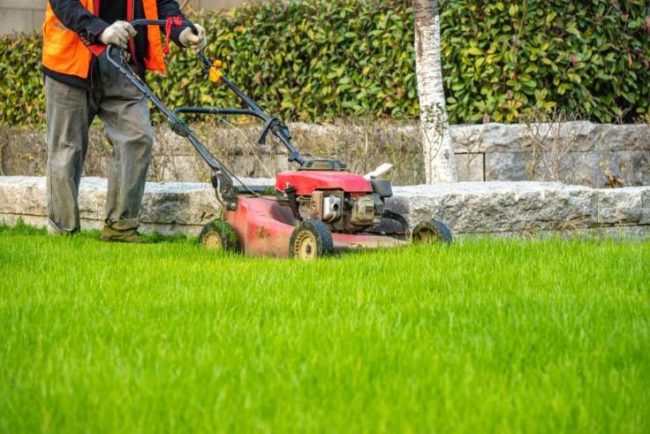
For young people transitioning from apartment life into homesteading, caring for a lawn can be a daunting task. If you’ve never had to do it before, you may not know where to start. It’s a little more complicated than just mowing your grass as short as possible every week during the summer. But, fortunately, it’s not that much more complicated.
If you know how often and how much to water and fertilize your lawn, you’re halfway to growing a thick, luscious, green carpet of grass your neighbors will envy. Of course, you should also know how long (or short) to cut your grass, how to deal with problem areas and how to handle large but routine maintenance tasks like aeration, overseeding and de-thatching.
Water Judiciously
If you live in a temperate region that gets a fair amount of rain, you may not need to water your grass at all. Grass needs about one inch of water a week, and any additional water you apply, via sprinklers or other irrigation systems, should be supplemental to the rainfall your grass receives. Of course, if you live in a dry climate or your region experiences a drought, you’ll need to water more often.
Make sure that when you do water your healthy lawn, you’re watering it evenly, so all parts of the lawn get the same amount of moisture. Distribute several empty tuna cans, or receptacles of a similar size, around the yard to get a feel for how much water the lawn is getting and how evenly. If you do water, do so in the morning.
If you’re growing cool-season turf grasses, and you live in a region where temps climb above 80 degrees Fahrenheit, your turf grass will go dormant and turn brown during the hottest mid-season months. You can prevent this by watering it weekly, or you can let it live out its natural life cycle — it will come back when temps cool off again. Just don’t bring it out of dormancy unless you’re planning to keep it there.
Fertilize at the Right Time of Year
Some hardcore lawn enthusiasts recommend fertilizing your lawn as often as four times a year. But unless you’re entering lawn and garden contests or being photographed for glossy magazine spreads, or you’re just really committed to having the best lawn in town, you probably don’t need to fertilize that often. For most lawns, a single yearly application of fertilizer is sufficient.
Make sure you know what type of grass you have, so you can choose the right fertilizer to

Cut Your Grass to the Right Length
Before you even begin cutting your grass, make sure your mower blades are sharp. Dull blades will tear rather than slice your grass, traumatizing it and leaving it vulnerable to disease.
The right length for your grass will depend on the weather and the type of grass you’re growing. Cut cool-season grasses, like Kentucky bluegrass or fescue, to a length of about two to two-and-a-half inches; cut warm season grasses, like Bermuda or St. Augustine, to a length of three-quarters of an inch to one-and-a-half inches. Cutting cool-season grasses a little longer keeps the roots shaded, so they can better withstand high summer temps. Regular mowing keeps your soil from getting too moist and protects your grass from disease. Don’t miss that last mow of the season — it can mulch any remaining fallen leaves and help the soil dry out in the spring so you will have a healthy lawn your neighbors will envy.
Keep Your Lawn Healthy
Most lawn care service providers will aerate, de-thatch and overseed your lawn for a reasonable price, especially considering that it can easily take you all day to perform these tasks yourself, even with power tools. But how often do these chores need to be performed?
You probably don’t need to aerate, de-thatch and overseed your lawn every year, if it looks like a healthy lawn and you’re happy with it. However, if your lawn has a lot of clay soil or is compacted from heavy use or heavy rainfall, it might benefit from aeration at least once a year. To see if your lawn needs to be aerated, remove a square foot section of sod going down at least six inches. If the roots of your turf grass don’t extend beyond the top one to two inches of surface soil, you need to aerate.
Tackle Problem Areas
Every lawn has problem areas, which can range from spots of heavy shade where nothing will grow, to dog damage, pest infestations and even diseases. But before you can solve a lawn problem, you have to diagnose it. If you need help, your local extension office is the place to find it. Not only will the experts there be able to help you identify the cause of your lawn woes, they may also be able to provide solutions so you can have a healthy lawn once again.
Taking care of a lawn is a lot of work, but it’s worth it when you’re relaxing on the patio, porch or deck with a cold drink on a hot summer’s day. You get out of your lawn what you put into it, so do the work to make it a place where family and friends can come together to play, swap stories, start homesteading and kick back. Having a healthy lawn is worth the work and part of having a healthy family!



